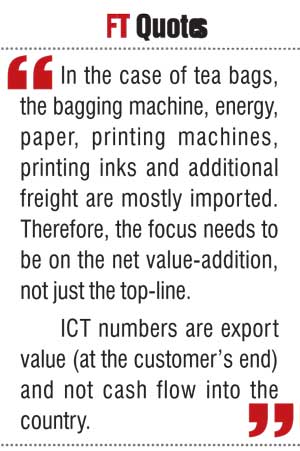Thursday Dec 04, 2025
Thursday Dec 04, 2025
Monday, 12 October 2015 00:00 - - {{hitsCtrl.values.hits}}

Hilmy Cader CEO MTI Consulting
MTI Consulting, based on their experience and thought leadership work in international trade strategising, have highlighted important export policy and governance issues that Sri Lanka should address.
What is the bottom-line on exports?
Sri Lanka’s measurement of exports is entirely based on revenue (essentially top-line) and does not measure the degree of value addition that would help determine export profitability to the country, as this is what Sri Lanka will eventually benefit from. For instance, in the case of tea bags, the bagging machine, energy, paper, printing machines, printing inks and additional freight are mostly imported. With apparel too, there is a high import-input component. Therefore, the focus needs to be on the net value-addition and not just the top-line. Having a consistent national formula for sector-wise value-addition would help Sri Lanka to make more effective policy decisions. The export sectors must be told how much ‘value-addition’ they have created for the economy, so that they are driven, rewarded and awarded by this KPI and not just top-line exports.
‘Show me the money’
Statistically, ICT has recorded an impressive 23% CAGR (over the 10 year period). This, however, is based on a voluntary survey declaration by a sample of ICT companies, which is then extrapolated to a national figure. More importantly, this is based on ‘Export Value’ i.e. the value of exports at the customer’s end. It is neither the revenue earned for Sri Lanka nor the cash inflow into Sri Lanka. This once again proves that our measurement of export revenue (as a top-line) is inconsistent and does not reflect the real export cash-flow into the country.
Exports = ‘Made in Sri Lanka’?
 As currently practiced, what is considered export earnings is the declared value of a good when it leaves a Sri Lankan port, with no consideration or interest in what happens beyond that point. While this encourages maximum value addition within Sri Lanka, it does not encourage Sri Lankan companies to become multinationals – which will require varying degrees of in-country value addition in export markets and even multi-country sourcing – provided that the Sri Lankan Exporters earn higher profits and that these profits are repatriated to Sri Lanka.
As currently practiced, what is considered export earnings is the declared value of a good when it leaves a Sri Lankan port, with no consideration or interest in what happens beyond that point. While this encourages maximum value addition within Sri Lanka, it does not encourage Sri Lankan companies to become multinationals – which will require varying degrees of in-country value addition in export markets and even multi-country sourcing – provided that the Sri Lankan Exporters earn higher profits and that these profits are repatriated to Sri Lanka.
Supply Chain vs. Demand Chain
The current approach to exports is based on each sector attempting to maximise its export revenue. Given the limited size of the Sri Lankan supply chain (natural and human resources) and the quantum increase in exports that is targeted (while ‘feeding’ the growing local demand), there is bound to be increasing competition for the country’s natural and human resources. Allowing this to be dictated entirely by the ‘invisible hand’ (market forces) may not be in the long term of strategic interest to the country and could also lead to socio-economic challenges. Therefore, a macro resource allocation model and policy is strongly recommended.
Ground realities
Over the last 10 years, Sri Lanka’s total exports have grown only by 7% (CAGR). During this 10 year period, apparel grew by 5%, tea by 8% and rubber by 12% (all in CAGR terms). These top sectors (including ICT) have continued to contribute as much as 70% to Sri Lanka’s exports. Tourism, unfortunately, is not captured as part of the published export compilations.
With the exception of the apparel sector and solid tires, the supply chain for other sectors is highly fragmented, with most businesses being unable to scale-up their operations. This fact has been proven by the 3700 plus Sri Lankan exporters who export over 30 diverse product categories. The share of branded and high tech exports as a percentage of Sri Lanka’s total exports is very low, even when compared to relevant emerging Asian competitors. The extremely low spend on R&D (as a nation) could be a contributory reason.